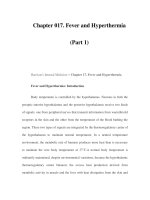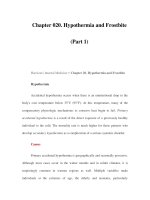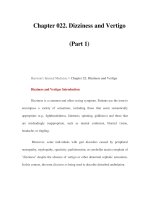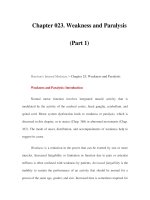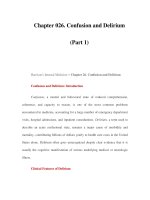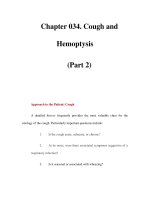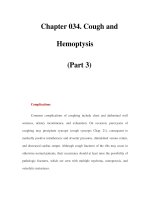Chapter 034. Cough and Hemoptysis (Part 1) docx
Bạn đang xem bản rút gọn của tài liệu. Xem và tải ngay bản đầy đủ của tài liệu tại đây (14.17 KB, 5 trang )
Chapter 034. Cough and
Hemoptysis
(Part 1)
Harrison's Internal Medicine > Chapter 34. Cough and Hemoptysis
Cough
Cough is an explosive expiration that provides a normal protective
mechanism for clearing the tracheobronchial tree of secretions and foreign
material. When excessive or bothersome, it is also one of the most common
symptoms for which patients seek medical attention. Reasons for this include
discomfort from the cough itself, interference with normal lifestyle, and concern
for the cause of the cough, especially fear of cancer.
Mechanism
Coughing may be initiated either voluntarily or reflexively. As a defensive
reflex it has both afferent and efferent pathways. The afferent limb includes
receptors within the sensory distribution of the trigeminal, glossopharyngeal,
superior laryngeal, and vagus nerves. The efferent limb includes the recurrent
laryngeal nerve and the spinal nerves. The cough starts with a deep inspiration
followed by glottic closure, relaxation of the diaphragm, and muscle contraction
against a closed glottis. The resulting markedly positive intrathoracic pressure
causes narrowing of the trachea. Once the glottis opens, the large pressure
differential between the airways and the atmosphere coupled with tracheal
narrowing produces rapid flow rates through the trachea. The shearing forces that
develop aid in the elimination of mucus and foreign materials.
Etiology
Cough can be initiated by a variety of irritant triggers either from an
exogenous source (smoke, dust, fumes, foreign bodies) or from an endogenous
origin (upper airway secretions, gastric contents). These stimuli may affect
receptors in the upper airway (especially the pharynx and larynx) or in the lower
respiratory tract, following access to the tracheobronchial tree by inhalation or
aspiration. When cough is triggered by upper airway secretions (as with postnasal
drip) or gastric contents (as with gastroesophageal reflux), the initiating factor can
go unrecognized and the cough may persist. Additionally, prolonged exposure to
such irritants may initiate airway inflammation, which can itself precipitate cough
and sensitize the airway to other irritants. Cough associated with gastroesophageal
reflux is due only in part to irritation of upper airway receptors or to aspiration of
gastric contents, as a vagally mediated reflex mechanism secondary to acid in the
distal esophagus may also contribute.
Any disorder resulting in inflammation, constriction, infiltration, or
compression of airways can be associated with cough. Inflammation commonly
results from airway infections, ranging from viral or bacterial bronchitis to
bronchiectasis. In viral bronchitis, airway inflammation sometimes persists long
after resolution of the typical acute symptoms, thereby producing a prolonged
cough that may last for weeks. Pertussis infection is also a possible cause of
persistent cough in adults; however, diagnosis is generally made on clinical
grounds (Chap. 142). Asthma is a common cause of cough. Although the clinical
setting commonly suggests when a cough is secondary to asthma, some patients
present with cough in the absence of wheezing or dyspnea, thus making the
diagnosis more subtle ("cough variant asthma"). A neoplasm infiltrating the
airway wall, such as bronchogenic carcinoma or a carcinoid tumor, is commonly
associated with cough. Airway infiltration with granulomas may also trigger a
cough, as seen with endobronchial sarcoidosis or tuberculosis. Compression of
airways results from extrinsic masses such as lymph nodes or mediastinal tumors,
or rarely from an aortic aneurysm.
Examples of parenchymal lung disease potentially producing cough include
interstitial lung disease, pneumonia, and lung abscess. Congestive heart failure
may be associated with cough, probably as a consequence of interstitial as well as
peribronchial edema. A nonproductive cough complicates the use of angiotensin-
converting enzyme (ACE) inhibitors in 5–20% of patients taking these agents.
Onset is usually within 1 week of starting the drug but can be delayed up to 6
months. Although the mechanism is not known with certainty, it may relate to
accumulation of bradykinin or substance P, both of which are degraded by ACE.
In contrast, angiotensin II receptor antagonists do not seem to increase cough,
likely because these drugs do not significantly increase bradykinin levels.
The most common causes of cough can be categorized according to the
duration of the cough. Acute cough (<3 weeks) is most often due to upper
respiratory infection (especially the common cold, acute bacterial sinusitis, and
pertussis), but more serious disorders, such as pneumonia, pulmonary embolus,
and congestive heart failure, can also present in this fashion. Subacute cough
(between 3 and 8 weeks) is commonly post-infectious, resulting from persistent
airway inflammation and/or postnasal drip following viral infection, pertussis, or
infection with Mycoplasma or Chlamydia. In the patient with subacute cough that
is not clearly post-infectious, the varied causes of chronic cough should be
considered. Chronic cough (>8 weeks) in a smoker raises the possibilities of
chronic obstructive lung disease or bronchogenic carcinoma. In a nonsmoker who
has a normal chest radiograph and is not taking an ACE inhibitor, the most
common causes of chronic cough are postnasal drip (sometimes termed the upper
airway cough syndrome), asthma, and gastroesophageal reflux. Eosinophilic
bronchitis in the absence of asthma has also been recognized as a potential cause
of chronic cough.
